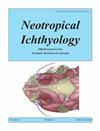随着时间的推移,安第斯河上的鱼类群落发生了变化
IF 2
4区 生物学
Q1 ZOOLOGY
引用次数: 7
摘要
基于13年的监测数据,我们描述了哥伦比亚马格达莱纳河流域的波尔切河在波尔切三世水电站建设后鱼类群落的变化。结果表明,本地物种数量明显减少,被外来物种所取代,特别是在水库中。在大坝建设前发现的4种本地物种明显消失,但在大坝建设后发现了12种新物种。我们分析了大坝周围水生环境β多样性的空间变化。水库产生的新环境呈现出独特的物种组成,对系统的总β多样性有重要贡献。水库形成后,总共出现了三种不同的新鱼类组合,以前只有三种,现在有六种。这种巨大的变化,在十年的建设中已经可见,突显了大坝建设对栖息地的影响有多强烈,以及鱼类群落在这个特有鱼类多样性的热点地区的反应有多迅速。我们的研究结果证明了监测鱼类群落对于揭示筑坝对河流生态系统的影响的重要性,并为马格达莱纳河流域其他地方潜在的互补鱼类多样性清单提供了信息。本文章由计算机程序翻译,如有差异,请以英文原文为准。
Fish community turnover in a dammed Andean River over time
ABSTRACT We describe the change in the fish community of the Porce River in Magdalena River Basin, Colombia, following the construction of the Porce III hydropower reservoir based on 13 years of monitoring data. The results show a clear reduction of the number of native species, which have been supplanted by colonizing non-native species, especially in the reservoir. Four native species detected prior to dam construction have apparently disappeared, but 12 new species were registered post-construction. We analyzed spatial changes in beta diversity in the aquatic environments surrounding the dam. The new environment generated by the reservoir presents a unique species composition and contributes significantly to the total beta diversity of the system. Altogether three distinct new fish assemblages emerged following reservoir formation and there are now six assemblages where there had previously been three. This dramatic change, already visible within a decade of construction, highlights just how strong of an impact dam construction has on habitats and how rapidly fish communities react in this hotspot for endemic fish diversity. Our findings demonstrate the importance of monitoring fish communities for revealing the impact of damming on river ecosystems and informs potential complementary fish diversity inventories elsewhere in the Magdalena River basin.
求助全文
通过发布文献求助,成功后即可免费获取论文全文。
去求助
来源期刊

Neotropical Ichthyology
生物-动物学
CiteScore
2.80
自引率
17.60%
发文量
24
审稿时长
6-12 weeks
期刊介绍:
Neotropical Ichthyology is the official journal of the Sociedade Brasileira de Ictiologia (SBI). It is an international peer-reviewed Open Access periodical that publishes original articles and reviews exclusively on Neotropical freshwater and marine fishes and constitutes an International Forum to disclose and discuss results of original research on the diversity of marine, estuarine and freshwater Neotropical fishes.
-Frequency: Four issues per year published only online since 2020, using the ‘rolling pass’ system, which posts articles online immediately as soon as they are ready for publication. A searchable and citable Digital Object Identifier (DOI) is assigned to each article immediately after online publication, with no need to await the issue’s closing.
-Areas of interest: Biology, Biochemistry and Physiology, Ecology, Ethology, Genetics and Molecular Biology, Systematics.
-Peer review process: The Editor-in-Chief screens each manuscript submitted to Neotropical Ichthyology to verify whether it is within the journal’s scope and policy, presents original research and follows the journal’s guidelines. After passing through the initial screening, articles are assigned to a Section Editor, who then assigns an Associate Editor to start the single blind review process.
 求助内容:
求助内容: 应助结果提醒方式:
应助结果提醒方式:


